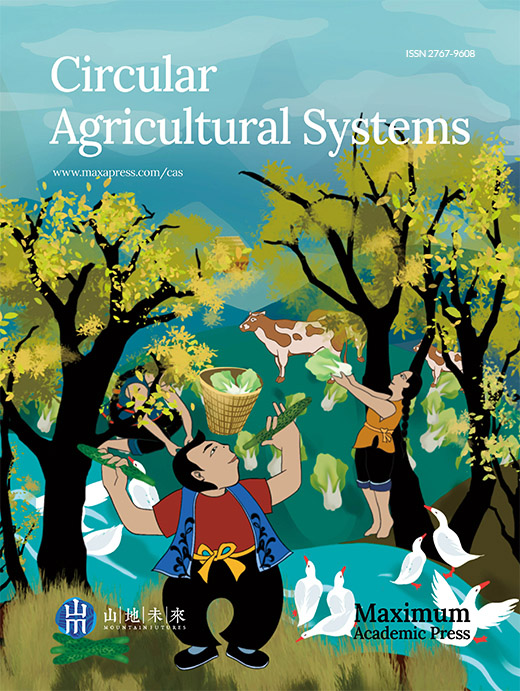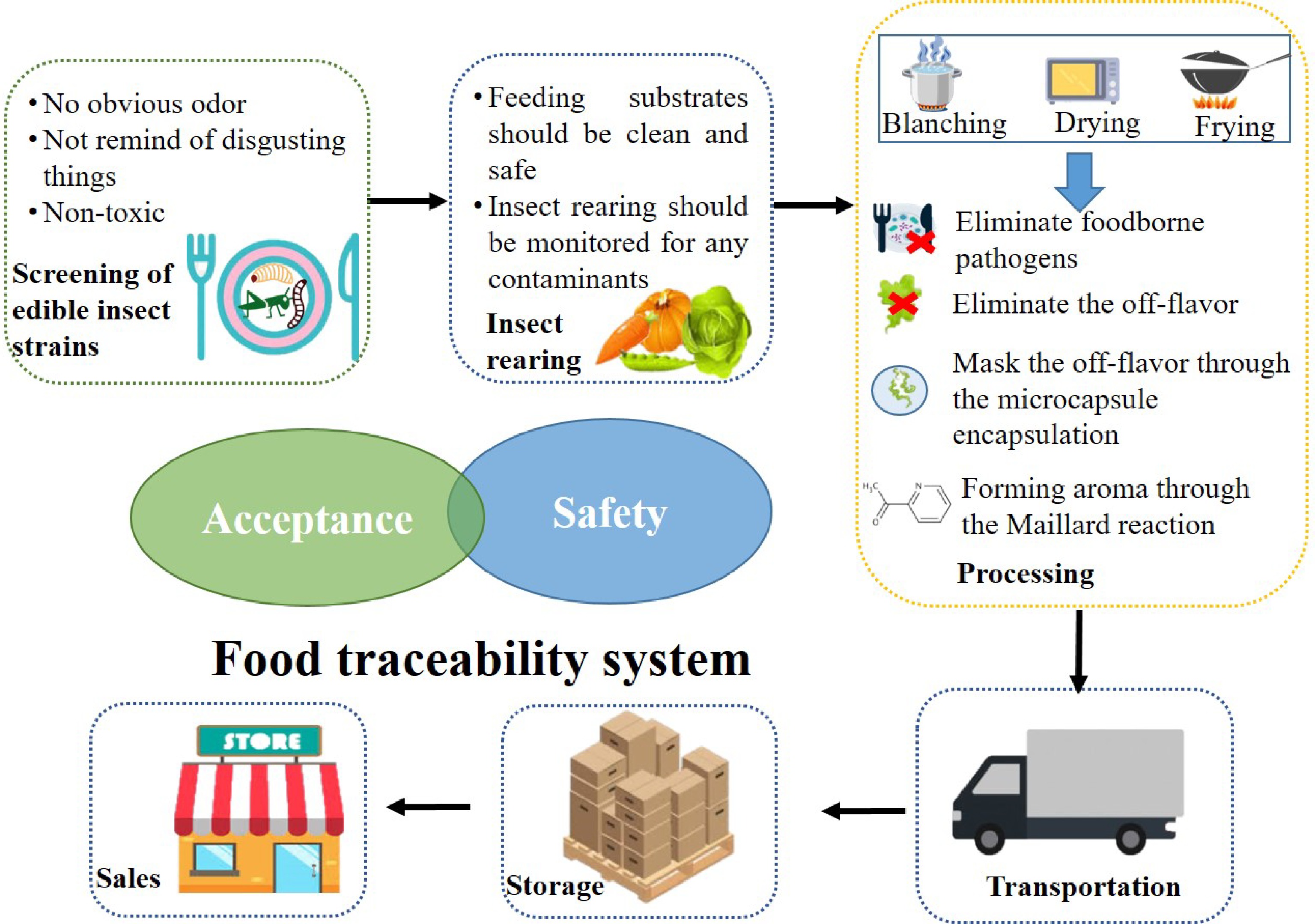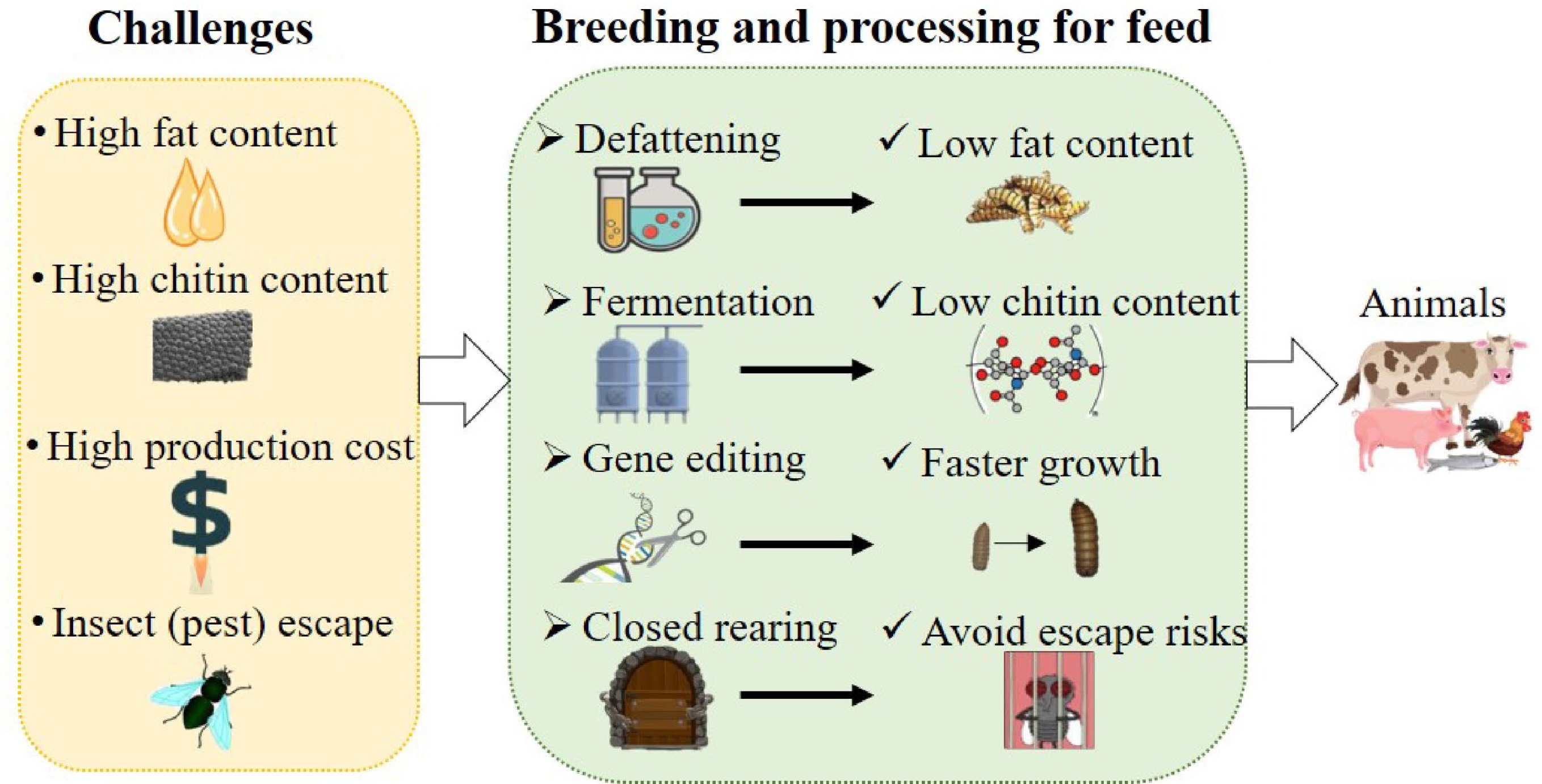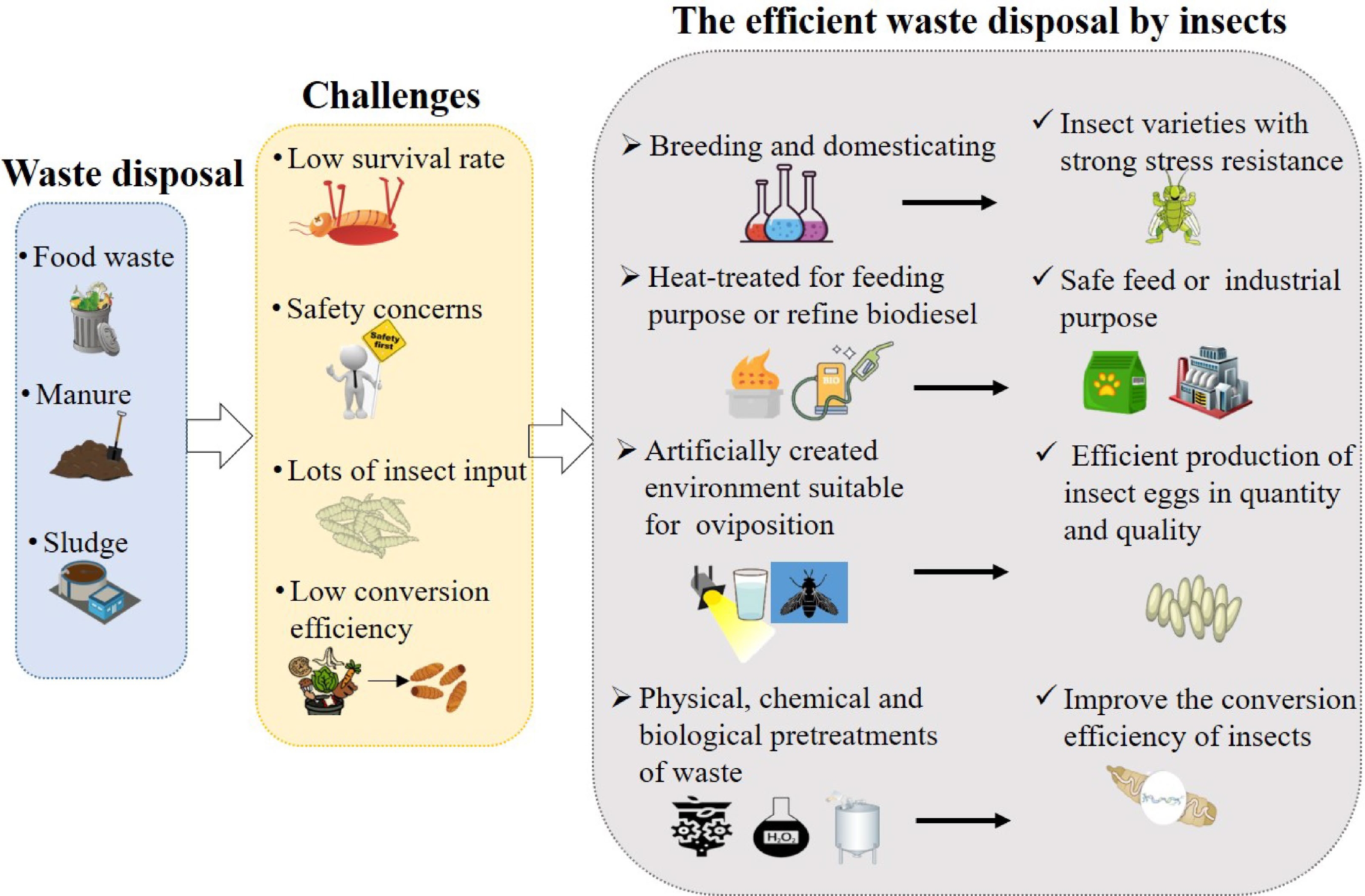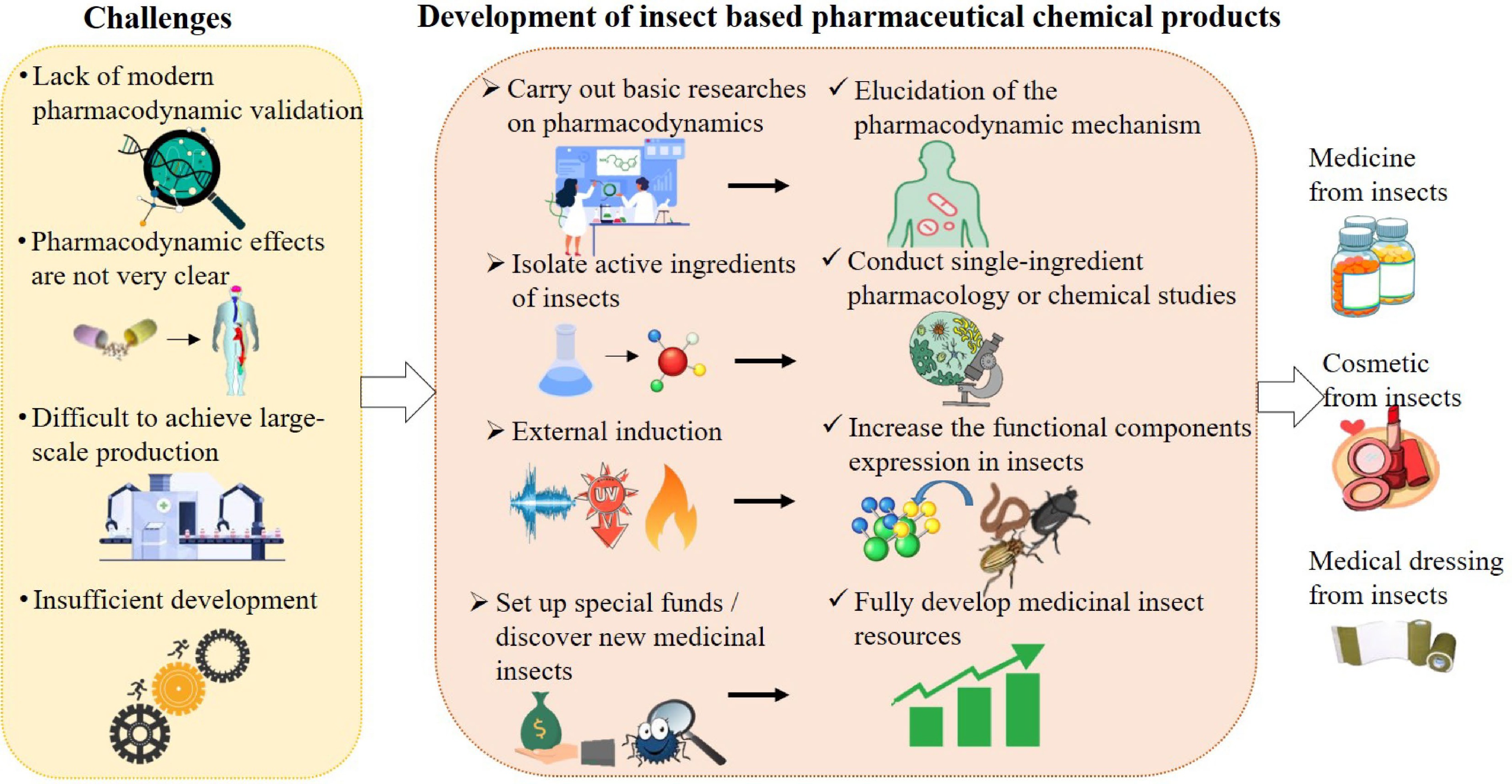-
In 2019, approximately 820 million people worldwide are still suffering from hunger, and about 2 billion people were unable to regularly obtain safe, nutritious and adequate food. On the other hand, our agricultural production systems put serious pressure on the sustainability of the environment and resources. In agricultural production systems, the livestock sector uses about 30% of the earth's land area, and its greenhouse gas emissions account for more than 70% of total agricultural emissions[1,2]. With the rapid development of animal husbandry, feed has become one of the main competitors for human food resources[3,4]. Therefore, finding sustainable alternative food sources is an extremely urgent task worldwide[5].
In recent years, insects have received increasing attention worldwide as a sustainable protein source that has not been fully exploited. According to a report from the International Insect Food and Feed Platform, European member states produced 6,000 tons of insect protein in 2019, and it is predicted that its output will reach 3 million tons by 2030[6]. Research on edible insects has increased dramatically in recent years. The literature on edible insects in the Scopus database has exploded since 2017, with more than 100 publications per year[7]. They are rich in high-quality proteins[8], various amino acids, polyunsaturated fatty acids, and minerals. In comparison with conventional livestock, insects emit less greenhouse gases, convert feed more efficiently[9], and use less land and water, resulting in a lower environmental footprint. They also have the advantage of fast growth, strong reproduction and high output efficiency. Therefore, insects can be used as a sustainable protein source for animal feed or human nutrition. As the nature’s most powerful recyclers, insects can convert organic waste into high-quality proteins and fats[10]. In addition, multiple studies have reported the medicinal properties of insects, such as anti-cancer[11], anti-oxidant[12], anti-hypertensive inflammatory[13], and anti-microbial[14] active substances.
Despite the many advantages of insects for use as food, feed, waste management and pharmaceuticals, there are still many problems with their widespread use. First and foremost is the low acceptability of insects as food. Some insects have unique off-flavor that adversely affects consumer preference[15]. A survey result of Flemish consumers showed that, from all animals protein sources, consumers have the lowest acceptance of insect protein[16]. Safety of insects as feed or food is of great concern due to their living habits. Although safety implications of insects have not been well documented, there are concerns about the potential risks such as protein allergy, microbial and chemical contaminants and heavy metal accumulation[17]. It is well known that insects such as mealworm and black soldier fly can be used for the management of waste such as plastic, livestock manure, and straw[18,19]. However, whether these wastes contain the necessary nutrients to support the survival and growth of these insects remains to be further studied[20]. With the development of economy and technology, the research and clinical application of medicinal insects have achieved remarkable results. Cantharidin, which is extracted from Mylabris caragnae, is used clinically to remove warts and treat cancer[21]. Maggots are applied to debride chronic wounds and have been widely recognized in clinical settings[22]. However, the research on the therapeutic effects, active ingredients and the pharmacological mechanisms of medicinal insects is still lacking and needs to be further explored.
This work analyzes the problems faced by insects when they are used for food, feeding, waste disposal and medicinal purposes, and puts forward corresponding countermeasures and suggestions, aiming to achieve targeted breeding of insects for specific purpose.
-
Many countries, such as China, Mexico and Thailand, have a long history of insect-eating. In recent years, edible insects have been referred to as 'future food' or 'novel food' by many scholars and frequently mentioned, which has set off a worldwide upsurge in research of edible insects[20,21]. The high protein content and the presence of various micronutrients, along with potential environmental benefits, make edible insects a main potential future food[23]. At present, the most consumed edible insects are mealworms, locusts, ants, crickets and silkworms[24]. However, whether edible insects can produce economic benefits depends on whether consumers buy it. Interest in edible insects remains low, especially among consumers in Western countries. Sensory attributes, consumer acceptance and safety issues remain major obstacles to their use as food sources.
The reasons consumers choose insect-based food have more to do with visual appearance, flavor, taste and price than environmental sustainability or its protein quality[25]. Some consumers, especially Western consumers, have a negative attitude towards eating insects. The visual appearance of some insects can be objectionable, even reminiscent of feces, mucus and spoilage, leading to consumer aversion to insect-based food. Fishy and earthy flavors of insect-based food also put off consumers[26,27]. To be incorporated into people's daily diet as a food, insects must first taste good and be able to attract consumers. In addition, safety of edible insects has also attracted much attention. It mainly involves harmful microorganisms, heavy metals, toxins, veterinary drugs and pesticide residues[28].
Although mealworm, black soldier fly, housefly and silkworm are considered to be the best potential insect species for industrial scale production[29], acceptance of mealworm as food is far higher than that of housefly. Therefore, insects intended for food purpose should be screened for those with no obvious smell and not easy to arouse consumers' disgust. In order to eliminate consumers' natural neophobia and aversion to edible insects, the sensory properties of insects can be improved by selecting appropriate processing methods. For example, insects can be crushed after drying to mask the appearance and make them invisible. The off-flavor of insect based food can be eliminated or masked by post-processing, such as reducing the concentration of odorous compounds through fermentation[30], forming an aroma similar to meat and nuts through the Maillard reaction caused by dry heat processing[25], and masking off-flavors through spray drying combined with microcapsule encapsulation. Deliciousness is the first element of food. Through various cooking, roasting and drying methods, improving the taste of edible insects can stimulate consumers' desire to eat them. When insects are used for edible purposes, they should meet food safety requirements. From the source, the feed substrate used for the production of insects must first be clean and safe to avoid possible contamination by heavy metals and chemicals. After the insects are harvested, processing such as blanching and drying should be used to reduce the microbial population and minimize the microbial risk associated with eating insects. The safety of insect food should also be guaranteed during subsequent processing, packaging, transportation, storage and sale. At the same time, a traceability system should be established so that the entire supply chain of insect food can be tracked from top to bottom to prevent food safety accidents[31]. In addition, it is necessary to establish a sound insect food standard system and related laws and regulations, and further improve the market supervision mechanism to ensure the safety of insect food (Fig. 1).
-
In order to meet the global requirements for nutritious food, more than 500 million tons of meat are needed for human consumption every year[32]. The high demand for meat has contributed to the rapid development of animal husbandry, leading to a shortage of animal feed and an increase in greenhouse gas emissions. Taking China as an example, in 2017, China imported 170 Tg of crops and 1.6 Tg of fishmeal, 86% of which was used as animal feed[33]. China's demand for feed protein has led to deforestation and other environmental damage at home and in exporting countries[34]. As a large amount of grain is used for the production of feed, the problem of competition between humans and animals for grain has arisen, posing a serious threat to food security. Plant biomass is an essential component of food and should be used by humans first[35]. In recent years, insects have been identified by most countries as a sustainable future source of protein for animal feed. Partial or total replacement of conventional protein sources in fish[36], poultry[37], and piglet[38] diets with insect protein has positive effects on animal health, production performance, and product quality. Edible insects have an average protein content of 25%–75%[39], and are rich in amino acids and minerals such as iron, zinc, and calcium that animals need, making them an ideal source of dietary protein[40]. In addition, the insect environmental footprint is low, and it has been reported that replacing fish meal with black soldier fly larvae as protein feed can significantly reduce global warming potential[41].
The fat in the feed is beneficial to improve the feed utilization rate and the weight gain rate of the animals. Insects have a high content of fat, with some lepidopterans having up to 10%−50% fat. However, high levels of dietary fat may be toxic to the gut microbes, resulting in reduced feed intake and reduced animal production[42]. For example, the fat content in beef or / and cattle feed is generally 2%~5%, and diarrhea or indigestion will occur when it exceeds 6%[43]. Edible insects contain more than 10% chitin, which interfere with protein digestion[17]. At present, the feed market is highly commodified, and the sales of various feeds are priced according to their protein content. There are still great challenges in how the cost and profitability of insects as feeds can compete with traditional feeds[44]. Moreover, the microbiological safety of insects is lower than that of traditional feeds[45]. Some insects are pests that, once released into the environment, can cause harm to crops, humans and animals. Housefly, for example, carry a lot of pathogens and cause up to US
${\$} $ Insects with low fat content can be obtained by adjusting the feeding matrix. The fat content in black soldier fly larvae can be reduced to 3% by reducing the dietary macronutrient content and protein to carbohydrate ratio in the feeding substrate[47]. Defattening is another feasible option to reduce the fat content of insects. Surendra et al.[48] reported that mechanical extrusion and solvent extraction could reduce crude fat content to 3.4%. The chitin content of insects can be reduced through processing. By physically separating the insect exoskeleton or adding Bacillus subtilis for fermentation, the chitin content can be reduced by about 20%[49]. In order to reduce the production cost of insects, gene editing technology can be used to develop insects with faster growth and stronger environmental adaptability. Zhan et al.[50] obtained a phenotype that can significantly improve the harvesting ability (body weight was 2.6 times that of control) of black soldier fly through the CRISPR/Cas9 gene editing method, which provides valuable technical resources for reducing their production costs. The method to reduce the safety risk of insects is to optimize and control the production and processing conditions at all stages of the supply chain[51], such as selecting clean and pollution-free feeding substrate, blanching or drying the harvested insects to kill most of the pathogenic microorganisms. High levels of Salmonella have been reported in mealworms cultured at an initial contamination level of 7 log cfu/g, whereas no Salmonella was detected in larvae cultured at an initial contamination level of 2 log cfu/g[52]. Blanching and toasting lowered the total viable count by 4−6 log cycles and completely eliminated the yeasts and moulds[53]. For pests such as housefly and locusts, a closed production environment should be guaranteed before death. So integrated production, breeding, harvesting and processing lines can be developed to keep the entire production chain of insect products in a closed environment, avoiding the escape of insects due to transshipment in separate production or processing links (Fig. 2).
-
Facing the reality of earth resource shortage, circular economy is the way of sustainable development in the future. Muscat et al.[54] pointed out that 'by-products from food production, processing and consumption should be recycled back into the food system'. Some edible insects have the ability to recycle organic waste. Under the action of enzymes and microorganisms in the gut, insects can degrade macromolecular nutrients in organic wastes into small molecular components, which are absorbed by the gut and used for their own metabolism[55]. The insect body can be used as a good protein source to provide protein feed for livestock and poultry. Some insects, such as yellow mealworms and black soldierflies, have a high content of fat and can be used to produce biodiesel[56]. Insect frass is a good organic fertilizer that can improve or maintain soil quality[57]. Generally, Protaetia brevitarsis larvae are used to degrade straw[58], black soldier fly larvae are used to treat food waste[59], and house fly larvae are used in the compost of livestock manure[60]. These insects can convert waste into their own protein and realize the recycling of waste.
However, the residues of antibiotics, heavy metals, mycotoxins and pesticides that may exist in organic wastes have adverse effects on insects[61,62]. Therefore, how to improve the survival rate of insects in waste disposal is the most important issue to be considered. There are also concerns about the safety of insects used for waste disposal as feed. The use of food waste as animal feed is currently banned in many countries, especially in Europe. On the other hand, the amount of organic waste generated is huge. China produces about 90 million tons of food waste[63] and 1459 million tons of manure each year[64]. The disposal of these wastes requires a large number of insect larvae input and efficient treatment. How to improve insect breeding ability and waste conversion efficiency to achieve large-scale waste disposal remains to be solved. In addition, the type, physical state, and chemical composition of organic waste also significantly affect the insect's disposal capacity. Such as the high heterogeneity of food waste, high lignin and cellulose content in straw, and antibiotic residues in livestock and poultry manure, all have adverse effects on the biotransformation of insects.
Breeding and domesticating insect varieties with strong stress resistance is an effective method to improve their survival rate in waste. Taking the treatment of discarded tobacco leaves as an example, the selected wild nicotine-tolerant insects are cultured for multiple generations in a fortified medium (the nicotine concentration in the medium is gradually increased), which can effectively improve the insect's tolerance to nicotine[65]. Physical and chemical stimulation can induce the expression of detoxification genes in insects and enhance their tolerance to toxic substances in waste. For instance, prior exposure to Cu enhances Spodoptera litura tolerance to xanthotoxin and β-cypermethrin[66,67]. Compared with the un-exposed group, exposing larvae to 50 mg·kg−1 and 75 mg·kg−1 of Cu increased 44.12% and 54.55% tolerance to β-cypermethrin and xanthotoxin, respectively. It is important to note that when implementing these inducing stimuli, the accumulation of harmful substances in the insect body should be avoided. Insects used for the management of food waste can be used as animal feed when safety is ensured (insects can be safe when heat-treated). Insects used to treat livestock manure sludge can be used for non-edible and feeding purposes, such as refining biodiesel, extracting chemical components and other industrial purpose. The efficient production of insect eggs in quantity and quality is the key to ensure the large-scale management of organic waste. Mating in some insects is regulated by sight, so in areas with longer winters or lower year-round sunshine, providing artificial lighting is key to successful indoor breeding[68]. Studies have demonstrated that some adult insects show color and sugar preferences for oviposition[69,70]. Compared to the white platforms, the weight and number of eggs laid by black solider flies on blue platforms increased by 350% and 250%, respectively. The mean area of black soldier flies ovaries fed with sucrose diets increased by 34.92% compared with that of black soldier flies fed with water. Before using insects for organic waste disposal, proper pretreatment of these wastes, such as pulverization and fermentation, can improve the conversion efficiency of insects. The organic waste is pulverized into small uniform particles, which are conducive to the ingestion of insects. Fermentation pretreatment can degrade lignin, cellulose and other substances in waste into components that are easily absorbed by insects through the action of microorganisms, thus increasing the conversion rate of waste by 50%[71]. Other pretreatment techniques such as alkaline peroxide pretreatment can remove a large amount of lignin in rice straw and improve the transformation efficiency (increased by 6.54%) of rice straw by black soldier fly larvae[72] (Fig. 3).
-
Insects are a precious drug resource library, and their biodiversity is much higher than that of plants and microorganisms. There are abundant active ingredients in insects that can be used in medicine, such as chitin, antimicrobial peptides, and melanin. The American cockroach is a well-known example of insect medicine. Pharmacological studies have shown that Periplaneta americana extract has antibacterial, anti-inflammatory, anti-tumor, anti-liver damage, promoting tissue repair, and improving immunity[73]. In China, insects have been used in more than 1,700 prescriptions of classic Chinese medicines, with more than 300 species[74]. In Europe, Coleoptera, Orthoptera and Hemiptera are used to treat diseases of the skin, respiratory system, nervous system and immune system[75]. In Mexico, ants are used to treat arthritis and chickenpox. In Africa, locusts and honey are used to treat malnutrition. In addition to medicine, insects are also used in the production of chemical materials. The pigment material from cochineal is used to dye cosmetics (such as lipstick and eyeshadow) and clothing[76]. Insect-based chitin and its derivatives are considered as a new potential material for cosmetic and cosmeceutical applications[77].
Although insects are an important part of traditional medicine in many parts of the world, the use of these insects is largely based on the experience of practitioners and records in traditional medicine books. Most of the active ingredients that exert medical effects in insects are unknown and lack modern pharmacodynamic validation[73]. Research on the pharmacodynamic mechanism of medicinal insects started relatively late, and initially focused on the crude extract mixture. Due to the complex components of the crude extract, the pharmacodynamic effects exhibited are the result of the interaction between the components, and some pharmacological effects may be amplified or cover up, creating an illusion[78]. Some active ingredients, such as antimicrobial peptides, have less content in insects, making it difficult to achieve large-scale production and application in medicine or chemical products. In addition, the development of medicinal insects is currently incomplete, and the utilization ratio is relatively low. Taking China as an example, there are about 1.5 million species of insects in China, and about 300 species of medicinal insects, accounting for only 0.02% of the total number of insects[79].
It is necessary to carry out a large amount of basic research to clarify the active ingredients of insect drugs or insect based chemical products. On this basis, advanced methods are used to extract and isolate these active ingredients for the study of the pharmacological or physicochemical properties of single ingredients. At present, there is little research on the efficacy and pharmacology of medicinal insects. The active ingredient of blister beetles against tumor was cantharidin. Through pharmacological experiments, Pan et al.[80] proved that cantharidin blocked pyruvate kinase M2 nuclear translocation by inhibiting pyruvate kinase activity, and then inhibited aerobic glycolysis pathway to prevent metastasis of breast cancer cells. Wang et al.[81] identified a bifunctional antithrombotic protein from insects and classified it by proteomic and transcriptomic analysis. Combined with pharmacological experiments, the diversity of antithrombotic components of Eupolyphaga sinensis and the molecular mechanism of traditional medicinal insects against thrombosis were revealed. The target functional components of insects can be enriched by external induction. For example, antimicrobial peptides can be induced by acupuncture, ultrasonic induction, ultraviolet induction and heat induction to increase their expression in insects[82]. For some insects that have a better understanding of the active ingredients, the research on clinical application can be strengthened. In view of the incomplete development of medicinal insect resources, special funds can be set up to conduct a comprehensive and systematic investigation of medicinal insect resources. In addition, the genetic relationship of insects can also be used to discover new drug sources from close-sourced species, and to find some rare medicinal insect substitutes (Fig. 4).
-
In addition to the above-mentioned edible, feeding, disposal waste and medicinal value, insects can also be used for ornamental, pollination, pest control and chemical production. However, insects used for different purposes also have distinct differences in their culture substrates, processing conditions, regulatory measures and corresponding production standards. As a producer, according to the purpose of use of various insects, the insects should be cultivated in a targeted manner to maximize their value. It should be noted that the escape of some harmful insects in the process of large-scale farming will cause safety hazards to crops, animals, humans and the environment. Therefore, a closed breeding environment should be adopted, new technologies should be continuously improved and perfected, and new policies, laws and regulations should be introduced according to the risks and characteristics of insect breeding, so as to control the risks of insect breeding technically and managerially. This study proposes a goal-oriented insect breeding and processing strategy, which is conducive to optimizing the structure of the insect industry, alleviating the difficulties faced by the industrialization of insect resources, and making it better suited to the development needs of the modern market.
This work was supported by Key R&D Program of Hebei (21327315D, 21373804D); the Special Research Assistant Funding Project of Chinese Academy of Sciences (E129ST15); the Strategic Priority Research Program of the Chinese Academy of Sciences (XDA28030302-4); Key Laboratory of Agricultural Water Resources-CAS (ZD201802); Strategic Priority Research Program of the Chinese Academy of Sciences (XDA28030302); Youth Innovation Promotion Association CAS (2021095); Hebei Dairy Cattle Innovation Team of Modern Agro-industry Technology Research System (HBCT2018120206).
-
The authors declare that they have no conflict of interest.
- Copyright: © 2023 by the author(s). Published by Maximum Academic Press, Fayetteville, GA. This article is an open access article distributed under Creative Commons Attribution License (CC BY 4.0), visit https://creativecommons.org/licenses/by/4.0/.
-
About this article
Cite this article
Wu X, Ma L, Bai Z, Wang X, Yuan Z, et al. 2023. Goal-oriented insect farming and processing can alleviate the dilemma faced by the industrialization of insect resources. Circular Agricultural Systems 3:1 doi: 10.48130/CAS-2023-0001
Goal-oriented insect farming and processing can alleviate the dilemma faced by the industrialization of insect resources
- Received: 28 September 2022
- Accepted: 31 January 2023
- Published online: 20 February 2023
Abstract: Insects are the most widely distributed and most abundant biological resources on earth, and are as precious a biological resource as plants and microorganisms. With the increasing population pressure and the serious shortage of food resources, insects as an ideal food substitute have gradually been paid more attention by scientists. In addition to being used as food and feed, the application value of insects in waste treatment, medicine and other aspects (such as ornamental and pollination) has also been widely recognized around the world. However, industrialization of insect resources still faces many challenges in terms of acceptability, safety, nutrition and productivity. We argue that insect mass production should be purpose-oriented and targeted cultivation. For example, insects used for food and feeding should be safe, tasty and nutritious. Insects used for waste disposal should maximize their survival rate and their conversion rate of the waste. For insects with medicinal significance, it is necessary to clarify their medicinal active ingredients and related pharmacological mechanism, and to cultivate insect strains with high content of active ingredients by proper induction. A goal-driven development strategy will help to avoid the risk of the insect industry technically and managerially.
-
Key words:
- Insects /
- Goal-driven development strategy /
- Industrialization /
- Specific purpose


